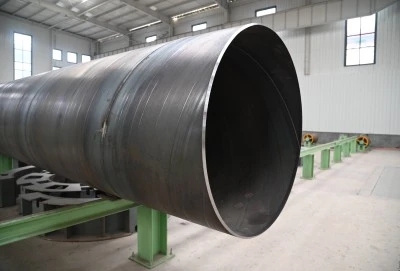Proper storage of Spiral Submerged Arc Welded steel pipe (SSAW Steel Pipe) is crucial for maintaining their quality, structural integrity, and longevity. SSAW steel channels are broadly utilized in different businesses, including oil and gas, water transportation, and development, due to their amazing quality and toughness.
|
|
|
Environmental conditions:
The environment in which SSAW steel pipes are stored plays a critical role in preserving their quality and preventing premature deterioration. It should be stored in a dry, well-ventilated environment that protects them from moisture and direct sunlight.
When selecting a storage area, consider covered warehouses or sheds that offer protection from rain, snow, and direct sunlight. If outdoor storage is unavoidable, use protective coverings such as tarpaulins or plastic sheets to shield the pipes from the elements. Ensure that these coverings are securely fastened to prevent them from being displaced by wind or other factors.
Proper ventilation is equally important in preventing moisture accumulation. If possible, elevate the pipes slightly off the ground using wooden blocks or racks to allow air to circulate underneath, further reducing the risk of moisture-related issues.
In coastal or industrial areas where the air may contain corrosive elements, additional precautions may be necessary. Consider using dehumidifiers in enclosed storage spaces or applying protective coatings to the pipes to provide an extra layer of defense against corrosion.
Stacking method:
The way SSAW steel pipe is stacked can significantly impact their condition during storage. Proper stacking methods help maintain the pipes' shape, prevent deformation, and ensure easy access for inspection and handling. The recommended approach is to stack the pipes horizontally, as this distribution of weight helps avoid bending and deformation that can occur with vertical storage.
When stacking SSAW steel pipes horizontally, it's crucial to provide adequate support between layers. Use wooden or rubber spacers at regular intervals along the length of the pipes to prevent direct contact between pipe layers. These spacers should be aligned vertically from one layer to the next to ensure even weight distribution and prevent localized stress points.
For larger diameter pipes, consider using cradles or specially designed racks that conform to the pipes' curvature. These supports help distribute the weight more evenly and reduce the risk of deformation, especially for pipes with thinner walls.
It's also important to ensure that pipes of similar diameter are stacked together. Mixing different sizes can lead to uneven weight distribution and potential damage. Additionally, arrange the pipes so that their ends are aligned on one side of the stack, making it easier to identify and access specific pipes when needed.
Stacking height:
The appropriate stacking height for SSAW steel pipe is a critical factor in safe and effective storage. The maximum stacking height should be determined based on several factors, including the pipes' diameter, wall thickness, and material properties. Excessive stacking height can lead to deformation of the bottom pipes due to the weight of the upper layers, potentially compromising their structural integrity.
As a general guideline, the stacking height for SSAW steel pipe should not exceed 1.5 meters (approximately 5 feet). However, this is not a one-size-fits-all rule and may need to be adjusted based on specific pipe characteristics. Pipes with larger diameters or thinner walls may require lower stacking heights to prevent deformation. When determining the appropriate stacking height, consider the following factors:
1. Pipe diameter: Larger diameter pipes generally require lower stacking heights due to their increased weight and potential for deformation.
2. Wall thickness: Pipes with thinner walls are more susceptible to deformation and may need to be stacked at lower heights.
3. Material grade: Higher-grade steel pipes may be able to withstand greater stacking heights due to their increased strength.
4. Storage duration: If pipes are to be stored for extended periods, consider reducing the stacking height to minimize long-term stress on the bottom layers.
5. Accessibility: Ensure that the stacking height allows for safe and easy access for inspection and handling.
It's always better to err on the side of caution and stack pipes at a lower height if there's any uncertainty. This approach helps protect the pipes from damage and ensures worker safety during handling and transportation.
Regular inspection:
Regular inspection of stored SSAW steel pipe is a crucial aspect of maintaining their quality and identifying potential issues before they escalate. Implementing a systematic inspection routine helps ensure that the pipes remain in optimal condition throughout their storage period and are ready for use when needed.
Establish a regular inspection schedule based on factors such as storage conditions, expected storage duration, and the pipes' intended application. For most situations, monthly inspections are recommended, but more frequent checks may be necessary in harsh environments or for critical-use pipes. During inspections, focus on the following key areas:
1. Corrosion and rust: Look for signs of surface rust or more severe corrosion, particularly at pipe ends, welds, and any areas where moisture may accumulate.
2. Deformation: Check for any bending, denting, or ovality issues that may have developed during storage.
3. Coating integrity: If the pipes have protective coatings, inspect for any damage, peeling, or degradation.
4. End protection: Ensure that end caps or covers are in place and undamaged to prevent internal contamination.
5. Stacking conditions: Verify that pipes remain properly stacked with adequate support and separation between layers.
6. Environmental factors: Assess the storage area for any changes in conditions that might affect the pipes, such as water leaks or increased humidity.
If any issues are recognized amid the review, take incite activity to address them. This may include cleaning and treating surface rust, reapplying defensive coatings, or altering capacity conditions. For more extreme issues, counsel the producer or a qualified designer to decide the best course of action. Maintain nitty gritty records of all reviews, counting dates, discoveries, and any remedial activities taken. These records can be profitable for quality confirmation purposes and for following the condition of channels over time.
SSAW Steel Pipe manufacturer:
LONGMA GROUP is a reputable manufacturer of pipes, offering products that meet various international standards. Their SSAW steel pipes comply with specifications including ASTM A53 Gr.B, API 5L (Gr.B, X42, X46, X52, X56, X60, X65, X70, X80 PSL1 and PSL2), ASTM A252, ASTM A500, AS/NZS 1163, AS/NZS1074, EN10219, EN10217, and others.
If you are in the market for high-quality SSAW steel pipes and seeking a reliable manufacturer, LONGMA GROUP welcomes your inquiries. You can contact them at info@longma-group.com for more information about their products, specifications, and how they can meet your project requirements.














